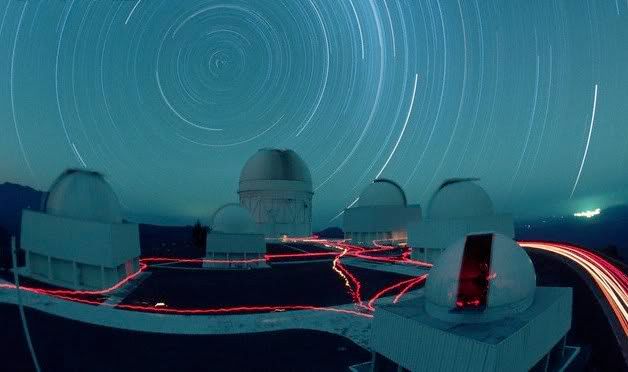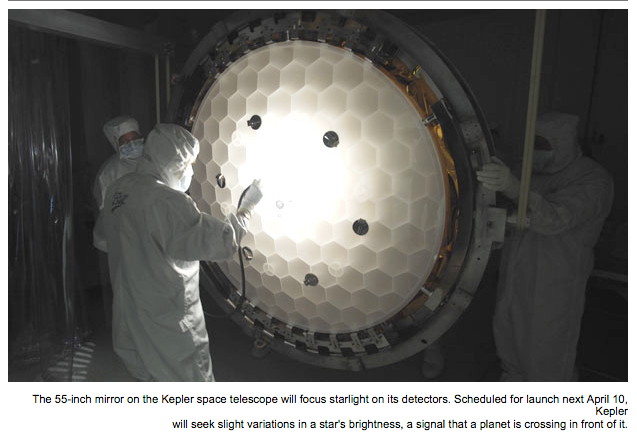It looks like you're using an Ad Blocker.
Please white-list or disable AboveTopSecret.com in your ad-blocking tool.
Thank you.
Some features of ATS will be disabled while you continue to use an ad-blocker.
4
share:
www.DailyGalaxy.com
(Click this link to view full article: www.DailyGalaxy.com)
www.DiscoverMagazine.com
(Click this link to view full article: DiscoverMagazine.com)
There isn't a duplicate planet earth. NASA is a group of lying occultists & power-hungry thugs (especially since it was established by the occult-government with the help of Nazis). There's life on other planets. Nothing just exists for no reason or comes out of no where without life.
[edit on 11-4-2009 by News And History]
Astronomers may be on the brink of discovering a second Earth-like planet, a find that would add fresh impetus to the search for extraterrestrial life, according to the journal Science. Astronomers from six major centers, including NASA, Harvard and the University of Colorado, outline how advances in technology suggest scientists are on the verge of being able to detect the presence of small, rocky planets, much like our own, around distant stars for the first time. The planets are considered the most likely habitats for extraterrestrial life.
One technique relies on observing the shift in light coming from a star as a planet swings around it. Until recently, this "radial velocity" method has only been sensitive enough to pick up planets far more massive than Earth, but improvements now make the discovery of a second Earth highly likely, said Dave Latham, a co-author on the paper at the Harvard-Smithsonian Center for Astrophysics.[/url]
(Click this link to view full article: www.DailyGalaxy.com)
www.DiscoverMagazine.com
Gliese 876 is a modest star, just one-third the mass of our sun and only 15 light-years away, but it has a history-making planetary system all its own. In 1998 a team led by Geoff Marcy of the University of California at Berkeley detected the first sign of something interesting there: a giant planet, twice the mass of Jupiter, circling Gliese 876 once every two months, its gravity yanking the star back and forth at the speed of a jet plane. Three years later the same group found a second planet, half the mass of Jupiter and closer in, pulling the star around at the speed of a race car. Although the planets are too faint to be seen directly, their motions cause the star’s spectrum to wobble back and forth across the digital detector of an astronomical telescope.
In the past decade, announcements of Jupiter-size planets have become commonplace; about 300 of them have been found so far. In 2005, however, with the help of improved detection software, Marcy’s team turned up something else orbiting Gliese 876—something truly new. This invisible object added one more regular component to the star’s motion, like the third note, faint and high, of a piano chord. It was another planet, orbiting in just two days and pulling on the star much more gently, not at jet plane or race car speeds but at a speed a man could run. This planet, dubbed Gliese 876 d, is clearly no Jupiter, Marcy realized. It is no more than seven or eight times as massive as our own: a “super-Earth.” Until then, all the known exoplanets (planets circling other stars) were big and gaseous, but this one is probably made of rocky materials—the first world like ours found in an alien solar system.
Gliese’s super-Earth lies so close to its star that it has just about no chance of being inhabited. If it has an atmosphere at all, it probably consists of dense steam, says Greg Laughlin of the University of California at Santa Cruz, a member of the discovery team. But if we can find one rocky, Earth-like planet right in our galactic backyard, surely there must be many more. Already, the Swiss astronomers who in 1995 discovered the first Jupiter-like exoplanet—and who are the great rivals of the California group in the exoplanet hunt—said in June that they had identified not one but three super-Earths orbiting a single star 40 light-years away. The smallest is just four times as massive as Earth. “We’ll find an Earth-mass planet by 2010,” Laughlin predicts, “and an Earth-mass planet that’s potentially habitable by 2012.”
(Click this link to view full article: DiscoverMagazine.com)
There isn't a duplicate planet earth. NASA is a group of lying occultists & power-hungry thugs (especially since it was established by the occult-government with the help of Nazis). There's life on other planets. Nothing just exists for no reason or comes out of no where without life.
[edit on 11-4-2009 by News And History]
I'm not sure if that last part is supposed to be sarcastic or not...
While its true we won't find a duplicate planet its only a matter of time until we find one that reminds us of home (aka is blue and green, has water, O2, and all the stuff we're familiar with).
While its true we won't find a duplicate planet its only a matter of time until we find one that reminds us of home (aka is blue and green, has water, O2, and all the stuff we're familiar with).
Unless we live in an eternal recurrance, in which case, at some point in the indeterminate infinite future, I'll be sitting here or somewhere, in the
very same configuration, typing the same letters on a qwewrty keyboard..
Very well plotted OP
It seems that, if there are Earth-type planets, we should be seeing the evidence within the next year or two. I read the Daily Galaxy link and was a bit surprised to see the Keppler Mission get a single passing mention. Keppler is capable of detecting planets as small as Mercury with attention paid to the 'habitable zone' of its parent star.
Currently we have discovered 172 stars with planets and, of those, 20 have multi planet solar systems. As you and the article mentions, the planets are highly unlikely to feature life. Their orbits are too close to the stars to preserve water in a liquid state etc. The latest planet we've found is another giant. Over 1000 times the size of Earth and 650 ly away Iota Draconis.
It seems 'obvious' to assume that the Keppler mission will provide the most information about extra solar planets...not for a long time. It'll take 3 to 4 years as it needs to detect a planet crossing its star more than once. It'll be looking at over a 100 000 stars and could yield results of hundreds or Earth-type planets in the next five years.
This four year wait gives other observatories the chance to pip Keppler to the post. As a human with an interested investment in the outcome, I don't care how they are discovered...the knowledge that planets might harbor life will be enough for now
[edit on 13-4-2009 by Kandinsky]
It seems that, if there are Earth-type planets, we should be seeing the evidence within the next year or two. I read the Daily Galaxy link and was a bit surprised to see the Keppler Mission get a single passing mention. Keppler is capable of detecting planets as small as Mercury with attention paid to the 'habitable zone' of its parent star.
Currently we have discovered 172 stars with planets and, of those, 20 have multi planet solar systems. As you and the article mentions, the planets are highly unlikely to feature life. Their orbits are too close to the stars to preserve water in a liquid state etc. The latest planet we've found is another giant. Over 1000 times the size of Earth and 650 ly away Iota Draconis.
It seems 'obvious' to assume that the Keppler mission will provide the most information about extra solar planets...not for a long time. It'll take 3 to 4 years as it needs to detect a planet crossing its star more than once. It'll be looking at over a 100 000 stars and could yield results of hundreds or Earth-type planets in the next five years.
This four year wait gives other observatories the chance to pip Keppler to the post. As a human with an interested investment in the outcome, I don't care how they are discovered...the knowledge that planets might harbor life will be enough for now
[edit on 13-4-2009 by Kandinsky]
new topics
-
University of Texas Instantly Shuts Down Anti Israel Protests
Education and Media: 1 hours ago -
Any one suspicious of fever promotions events, major investor Goldman Sachs card only.
The Gray Area: 3 hours ago -
God's Righteousness is Greater than Our Wrath
Religion, Faith, And Theology: 8 hours ago -
Electrical tricks for saving money
Education and Media: 11 hours ago
top topics
-
VP's Secret Service agent brawls with other agents at Andrews
Mainstream News: 12 hours ago, 10 flags -
Cats Used as Live Bait to Train Ferocious Pitbulls in Illegal NYC Dogfighting
Social Issues and Civil Unrest: 16 hours ago, 8 flags -
Nearly 70% Of Americans Want Talks To End War In Ukraine
Political Issues: 13 hours ago, 4 flags -
Sunak spinning the sickness figures
Other Current Events: 13 hours ago, 4 flags -
Electrical tricks for saving money
Education and Media: 11 hours ago, 4 flags -
Late Night with the Devil - a really good unusual modern horror film.
Movies: 15 hours ago, 2 flags -
Any one suspicious of fever promotions events, major investor Goldman Sachs card only.
The Gray Area: 3 hours ago, 2 flags -
University of Texas Instantly Shuts Down Anti Israel Protests
Education and Media: 1 hours ago, 1 flags -
God's Righteousness is Greater than Our Wrath
Religion, Faith, And Theology: 8 hours ago, 0 flags
4


